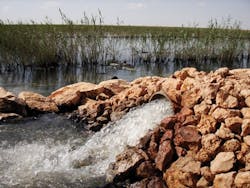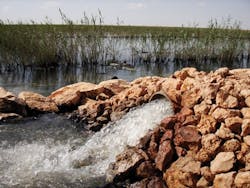New York DEP Completes Construction on Nitrogen Reduction Facility
The New York City Department of Environmental Protection has completed construction of a carbon addition facility at the 26th Ward Wastewater Treatment Plant that will reduce the amount of nitrogen discharged into Jamaica Bay by more than 3,000 pounds per day, or nearly 10% of total nitrogen discharges to the bay.
As part of a historic agreement announced by Mayor Bloomberg, the New York State Department of Environmental Conservation, the Natural Resources Defense Council and other environmental stakeholders in 2010, the nearly $2 million facility is part of $115 million in total new investments committed to reducing nitrogen discharges into Jamaica Bay by more than 50% over 10 years.
In early 2010, approximately 40,000 pounds of nitrogen were being discharged into the bay every day. With the addition of the new facility, DEP will reduce that level by roughly 7,000 pounds. The facility was constructed on-site at the 26th Ward Wastewater Treatment Plant in Starrett City, Brooklyn.
"As part of our ongoing commitment to protect, preserve and improve the ecosystem of Jamaica Bay, nitrogen reduction is an important upgrade to the 26th Ward Wastewater Treatment Plant," said Environmental Protection Commissioner Carter Strickland. "DEP has made it clear that the protection of this national treasure is among its top priorities and we have committed $115 million to specifically remove nitrogen discharges into this waterbody. Along with $8.9 billion in water quality investments by Mayor Bloomberg, this is yet another example of why New York's waterways are cleaner than they have ever been in 100 years of testing."
The carbon facility will remove nitrogen from wastewater effluent through the addition of glycerol, a high carbon biological byproduct of biodiesel production that is non-hazardous and non-flammable. The new facility pumps glycerol into the wastewater aeration tanks, where the glycerol then separates nitrogen from the nitrate and nitrite molecules.
In addition to the upgrades to 26th Ward, improvements are progressing at the Jamaica Wastewater Treatment Plant and will begin at the Coney Island Wastewater Treatment Plant in Brooklyn and the Rockaway Wastewater Treatment Plant in Queens. The first of these will be operational in 2015, and all improvements will be completed by 2020.
These investments, made in concert with $95 million the city already has committed for nitrogen control upgrades, will reduce the nitrogen discharged into Jamaica Bay by nearly 50% over the next 10 years. This is in addition to the $770 million DEP has invested in nitrogen reduction measures at the four Upper East River wastewater treatment plants: Bowery Bay, Hunts Point, Tallman Island and Wards Island. These projects are scheduled to be completed this year, and will reduce total nitrogen discharges into the East River by more than 52%.
The 26th Ward Wastewater Treatment Plant went into operation in 1944 and serves more than 283,000 residents. Located in eastern Brooklyn, it treats up to 85 million gallons of wastewater a day and up to 170 mgd during wet weather events. New Yorkers produce, and DEP treats, an average of 1.3 billion gallons of wastewater every day. The wastewater is collected through 7,400 miles of lateral sewers that flow downhill by gravity or pumping into large interceptor sewers, which lead directly to the city's 14 wastewater treatment plants.
More WaterWorld Current Issue Articles
More WaterWorld Archives Issue Articles

